
| Version | Summary | Created by | Modification | Content Size | Created at | Operation |
|---|---|---|---|---|---|---|
| 1 | MOHAMMADAMIN SADEGHI | -- | 3964 | 2024-01-11 09:37:10 | | | |
| 2 | Fanny Huang | Meta information modification | 3964 | 2024-01-12 07:09:31 | | | | |
| 3 | Fanny Huang | -4 word(s) | 3960 | 2024-01-16 07:27:48 | | |
Video Upload Options
Owing to the solid lubrication characteristic of Diamond-like carbon coatings (DLCs), which reduces wear and friction and protects contacting surfaces from degredation, DLCs are often used in industrial machinery and harsh environments. DLC coatings are optimized by adjusting operating and deposition parameters as well as doping them with other elements to improve performance, such as thermal stability and chemical resistance. Ionic liquid (ILs) are a promising green lubricant option due to their low melting temperature, superior thermal stability, and acceptabble miscibility with organic substances. ILs have been studied as main lubricants and additives to the main lubricants, and their tribological properties have been investigated, including their use as extreme temperature lubricants. The tribological properties of pure/doped DLC coatings with ILs have also been explored, although limited research has been conducted in this area. The combined synergistic effect of DLCs and ILs shows great promise in reducing energy loss due to friction, promoting longevity, and conserving energy.
1. Introduction
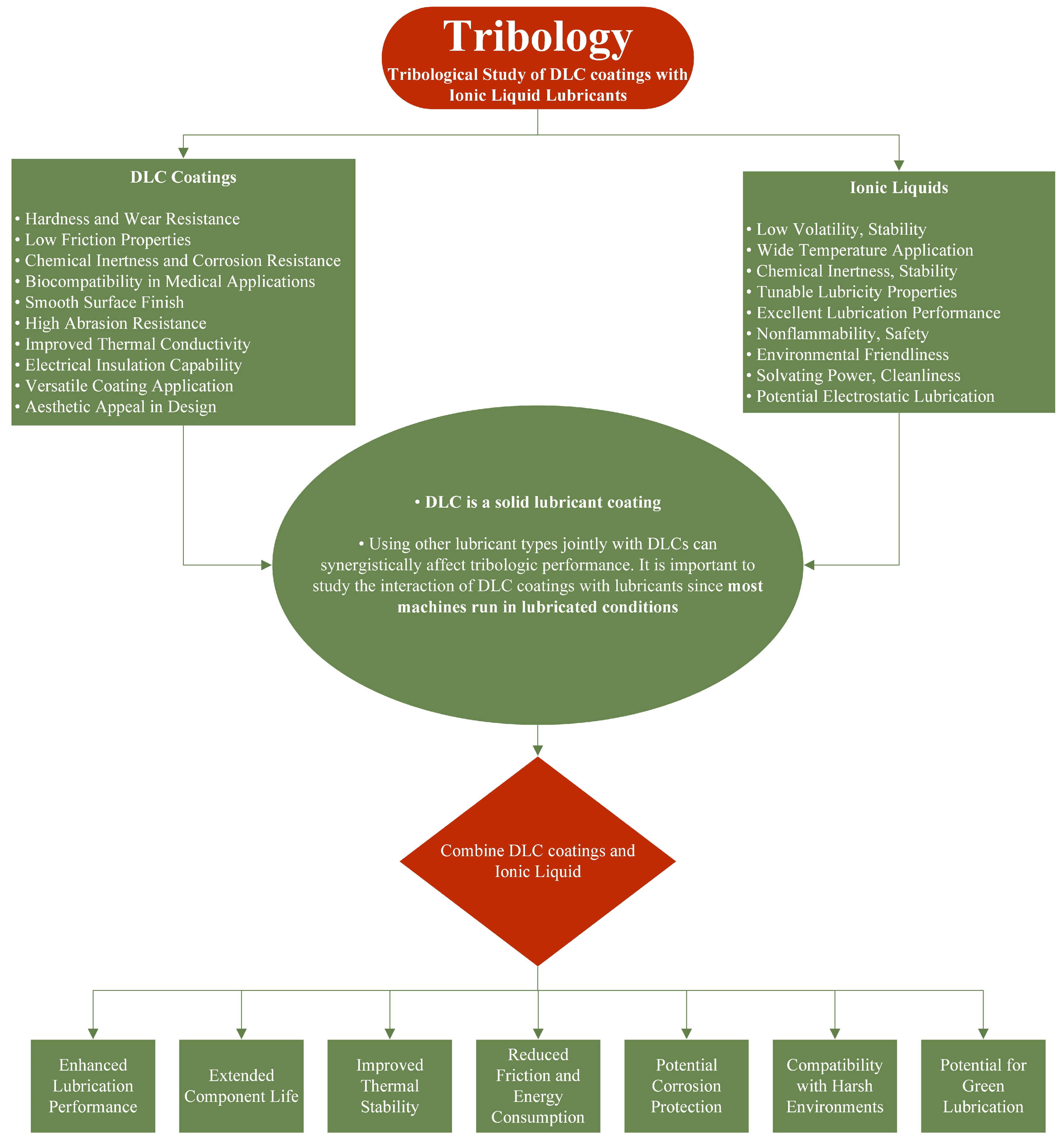
2. Tribological Testing of DLC Coatings with Ionic Liquid Lubricants
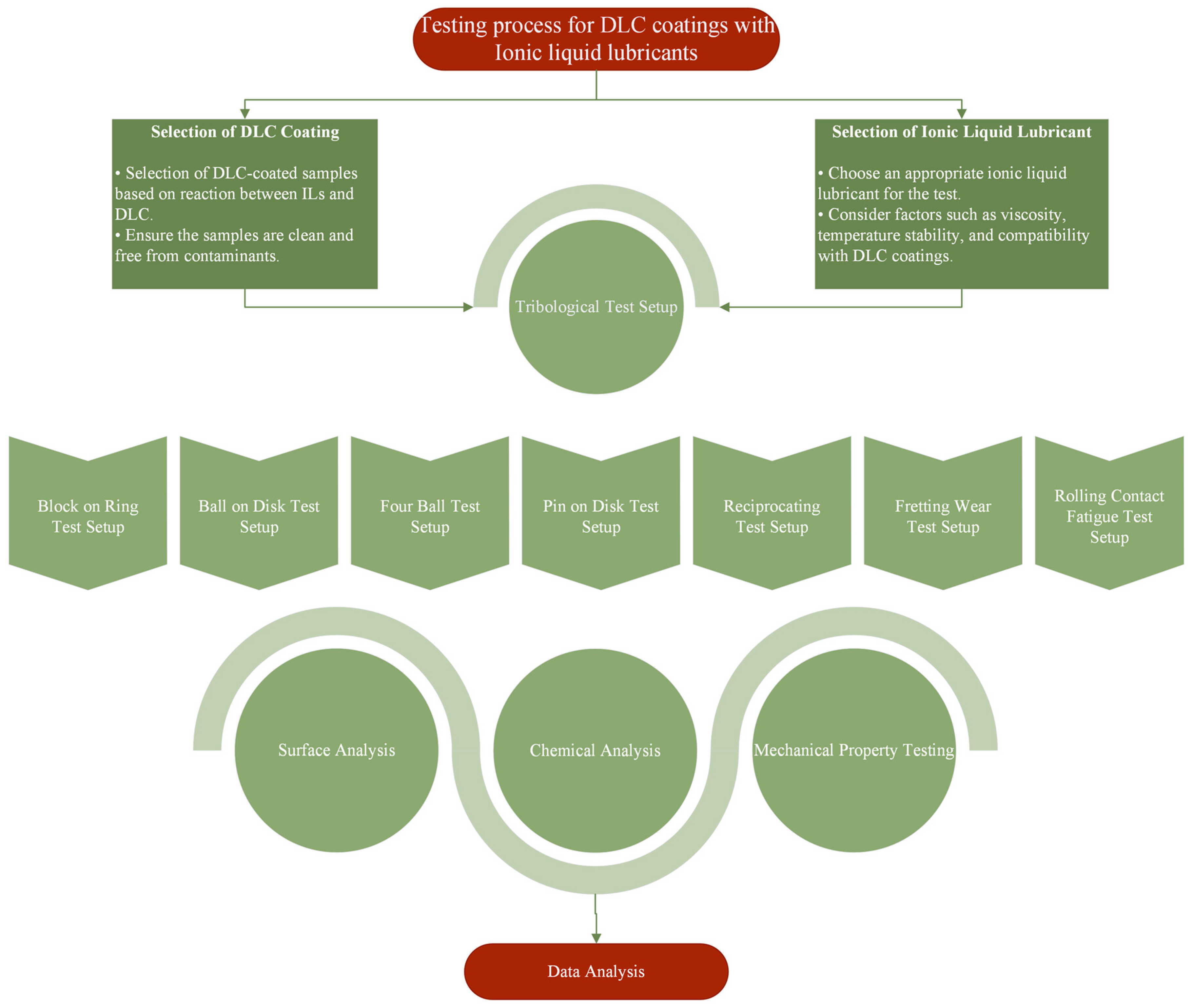
2.1. Tribology of Pure Diamond-like Carbon Coatings and Ionic Liquids
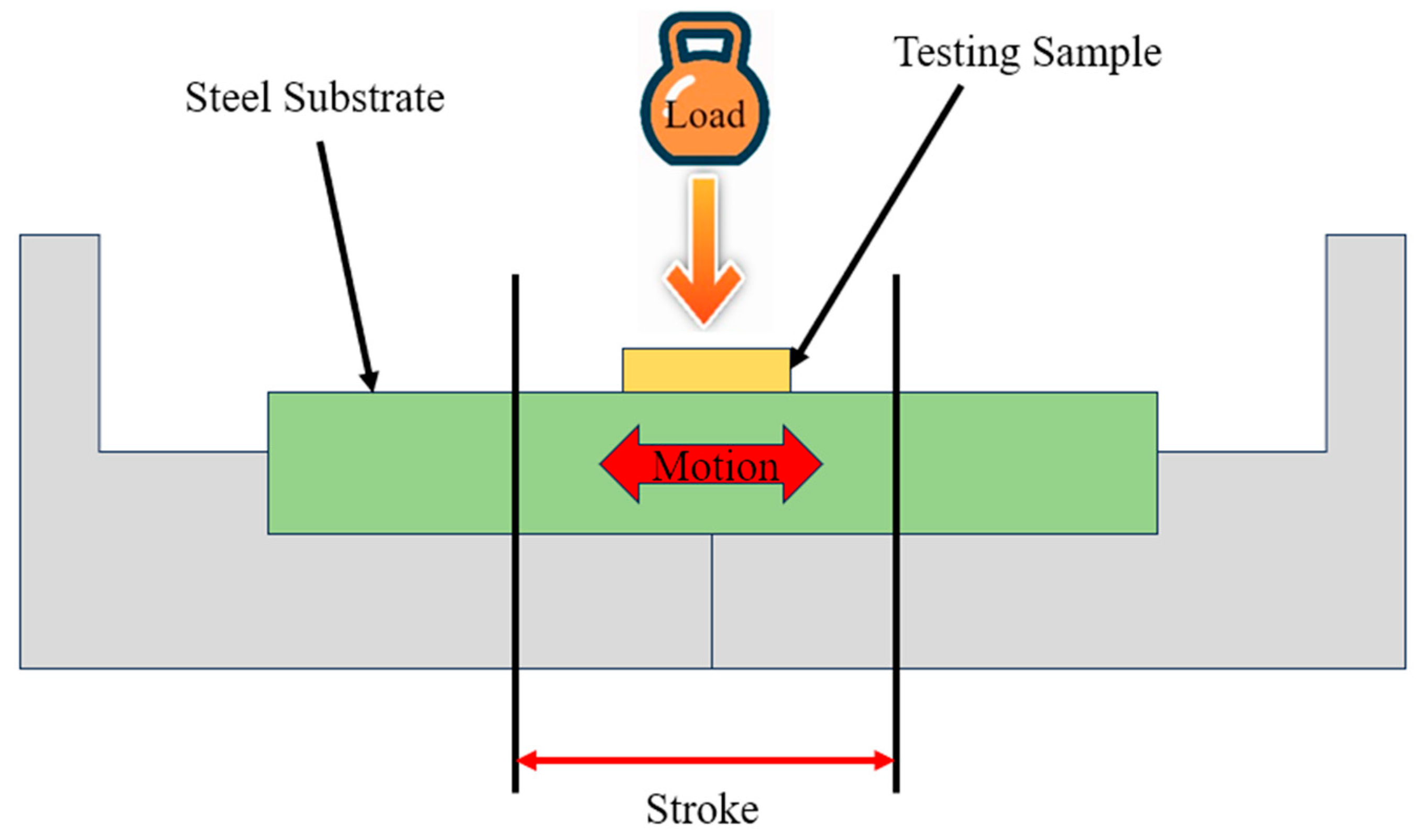
| Name of ILs | Tribometer | Additive or Main Lubricant? | Ref. |
|---|---|---|---|
| 1-octyl-2,3-Dimethylimidazolium bis(trifluoromethyl)sulfonyl | UMT-3 tribometer (ball-on-plate) | Used as main lubricant (100 wt.%) | [31] |
| 1-butyl-1-methylpyrrolidinium tris(pentafluoroethyl)trifluorophosphate | CETR-UMT-3 micro-tribometer (ball-on-plate) | Used as both additive in PAO 6 (1 wt.% additive) and main lubricant (for comparison) | [32] |
| ethyl-dimethyl-2-methoxyethylammonium tris(pentafluoroethyl)trifluorophosphate | UMT-3 microtribometer (ball-on-plate) | Used as both additive in PAO 6 (1 wt.%) and main lubricant (for comparison) | [33] |
| The synthesized ionic liquids of functionalized borate esters (The specific names are not mentioned but molecular structure is explained in the article) | Reciprocating friction and wear tester (ball-on-disk) | Used as 2 wt.% additives to polyalphaolefin (PAO 6) and compared with 2 wt.% ZDDP as a reference additive | [34] |
| (1) 1-butyl-3-methylimidazolium tetrafluoroborate And (2) trihexyltetradecylphosphonium bis(trifluoromethy-lsulphonyl) amide |
T-01M tester (ball-on-disc configuration) | Used as main lubricant (100 wt.%) | [35] |
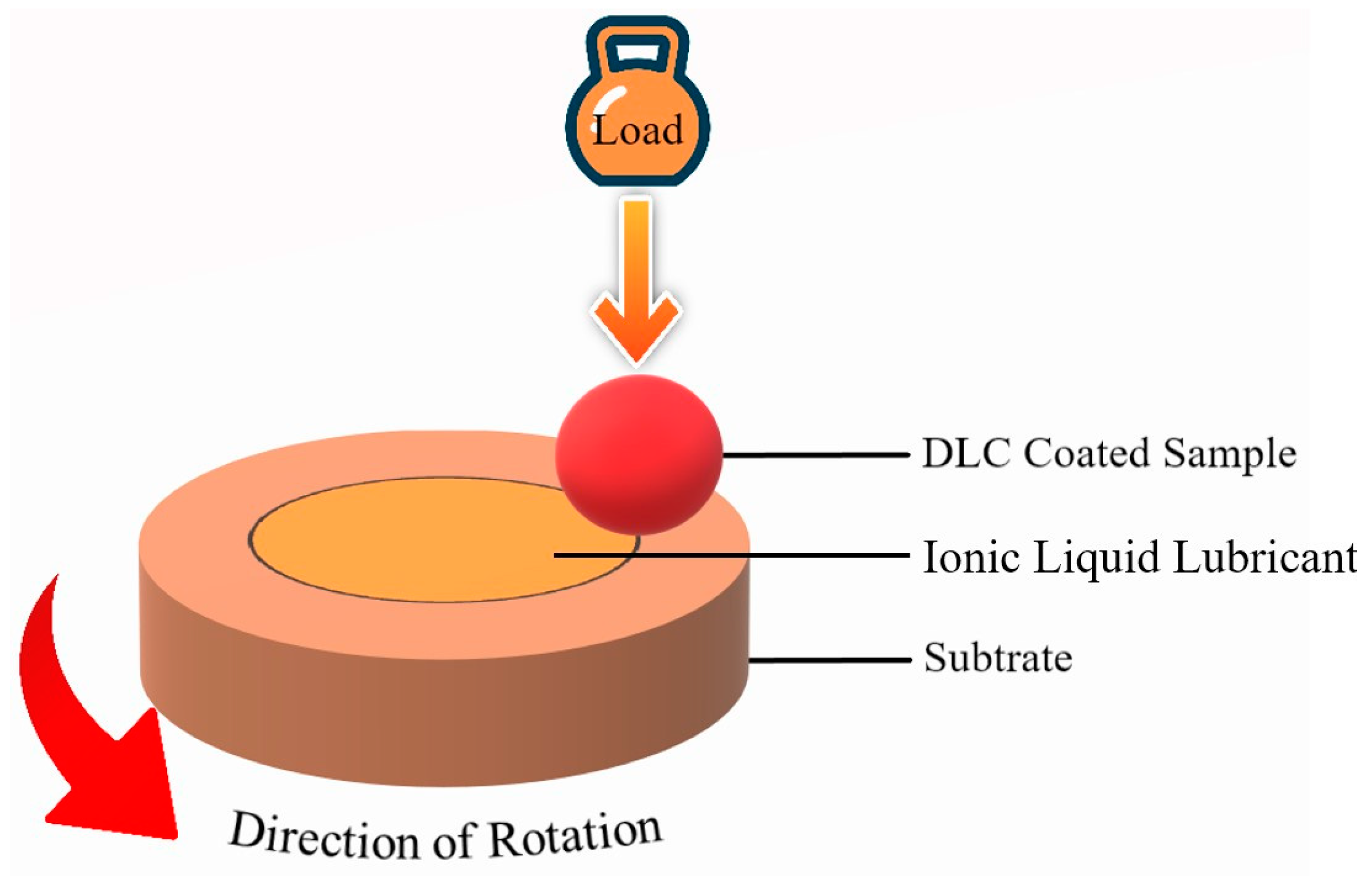
2.2. Tribology of Doped Diamond-like Carbon Coatings and Ionic Liquids
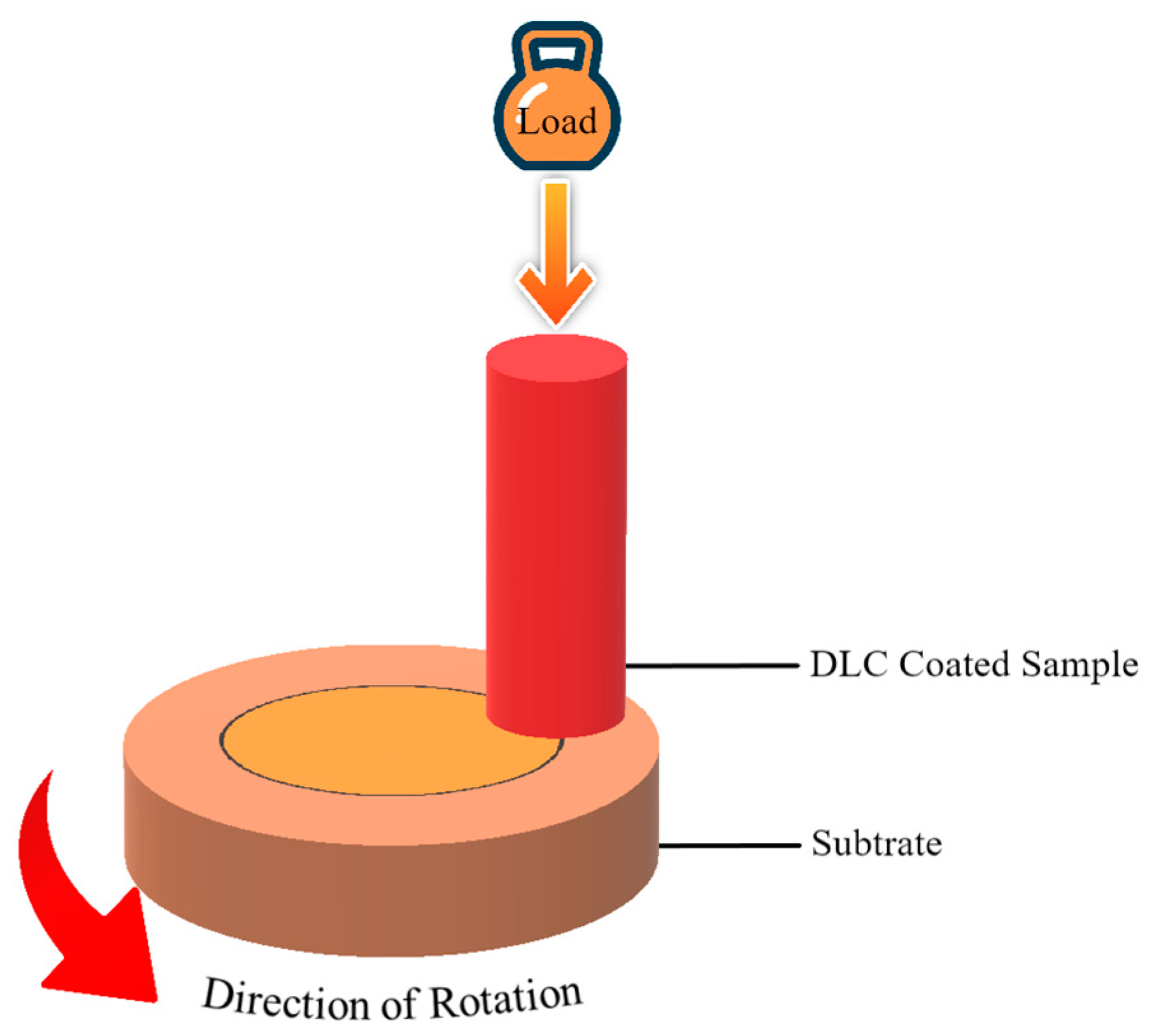
| Name of Ionic Liquids | Tribometer | Doped DLC Type | Ref. |
|---|---|---|---|
| dialkyloimidazolium tetrafluoroborates (Used as main lubricant, i.e., 100 wt.%) | T-01M tribometer (ball-on-disc configuration) | W-doped DLC | [36] |
| tributylmethylphosphonium dimethylphosphate (PP) (used as additive with 1 wt.%) and 1,3-dimethylimidazolium dimethylphosphate (IM) (used as additive with 1 wt.%) and 1-butyl-1-methylpyrrolidinium tris(pentafluoroethyl)trifluorophosphate (BMP) (used as additive with 1 wt.%) |
TE 38-Phoenix Tribometer (reciprocating pin-on-disc tribometer) | W-doped DLC, and Ag-doped DLC | [23] |
| 1,3-dimethylimidazolium dimethylphosphate (used as additive with 1 wt.%) | UMT-2 tribometer with (ball-on-flat-disc geometry) | W-doped DLC | [37] |
| (1) 1-butyl-1-methylpyrrolidinium tris(pentafluoroethyl) trifluorophosphate ([BMP][FAP]) (used as additive with 1 wt.%) and (2) tributyl-methyl-phosphonium dimethylphosphate (PP) (used as additive with 1 wt.%) and (3) (2-hydroxyethyl) trimethylammonium dimethylphosphate (AM) (used as additive with 1 wt.%) |
UMT-2 tribometer (reciprocating motion with a ball-on-flat-disc geometry) | W-doped DLC | [38] |
| (1) tetrafluoroborate (LB104) or [BF4] (LB104) (used as main lubricant, i.e., 100 wt.%) And (2) tetrafluoroborate (LAB103) or [BF4] (LAB103) (used as main lubricant, i.e., 100 wt.%) |
CSM Switzerland tribometer (ball-on-disc) | Cr-doped GLC and Cr-doped DLC |
[26] |
| trihexyltetradecylphosphonium bis (2-ethylhexyl) phosphate [P_66614] [DEHP] (used as additive with 1 wt.%) | Block-on-Ring configuration | Gd-DLC and Eu-DLC | [39] |
| trihexyltetradecylphosphonium bis(trifluoromethylsulfonyl) amide (used as main lubricant, i.e., 100 wt.%) | Anton Paar TRB tribometer (Ball-on-disc configuration) | Si-DLC | [40] |
| 1-alkyl-3-octylimidazolium hexafluorophosphate (L-P801) (used as main lubricant, i.e., 100 wt.%) And 1-alkyl-3-octylimidazolium hexafluorophosphate (L-P804) (used as main lubricant, i.e., 100 wt.%) |
UMT-2MT (reciprocating ball-on-disk) | Ti-DLC | [41] |
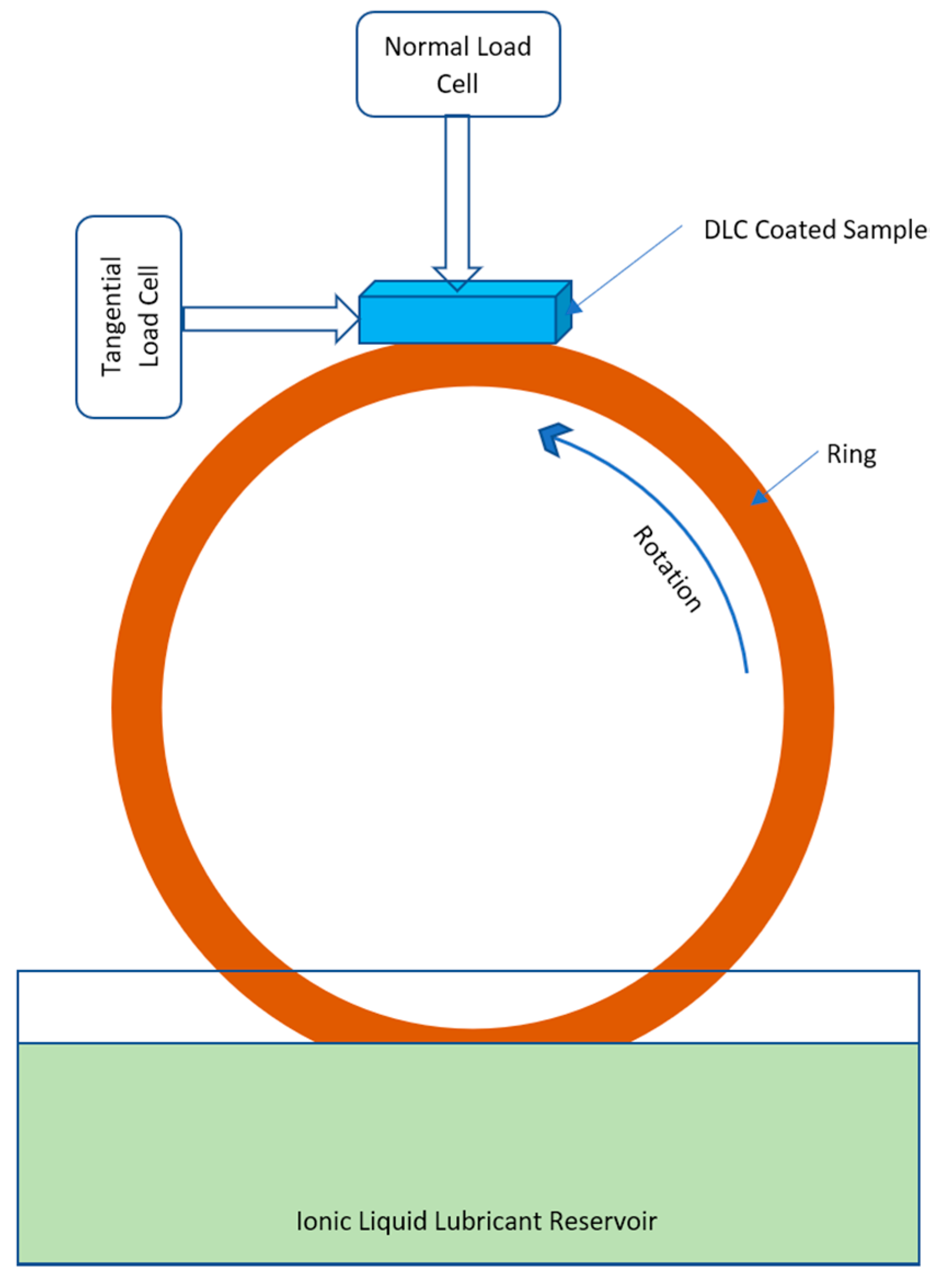
References
- Holmberg, K.; Erdemir, A. The Impact of Tribology on Energy Use and CO2 Emission Globally and in Combustion Engine and Electric Cars. Tribol. Int. 2019, 135, 389–396.
- Holmberg, K.; Andersson, P.; Erdemir, A. Global Energy Consumption Due to Friction in Passenger Cars. Tribol. Int. 2012, 47, 221–234.
- Pinkus, O.; Wilcock, D.F. Strategy for Energy Conservation through Tribology; American Society of Mechanical Engineers: New York, NY, USA, 1977.
- Kimura, Y.; Tanaka, M.; Enomoto, Y. Tribology Research in Japan—A State-of-the-Art Report. Proc. Inst. Mech. Eng. Part J J. Eng. Tribol. 1996, 210, 159–172.
- National Research Council of Canada. Associate Committee on Tribology. A Strategy for Tribology in Canada: Enhancing Reliability and Efficiency through the Reduction of Wear and Friction; National Research Council of Canada: Ottawa, ON, Canada, 1986.
- What Is the Kyoto Protocol?|UNFCCC. Available online: https://unfccc.int/kyoto_protocol (accessed on 21 March 2023).
- The Paris Agreement|UNFCCC. Available online: https://unfccc.int/process-and-meetings/the-paris-agreement (accessed on 21 March 2023).
- Q&A: Commission Proposal on the New Euro 7 Standards. Available online: https://ec.europa.eu/commission/presscorner/detail/en/qanda_22_6496 (accessed on 21 March 2023).
- Reeves, C.J.; Siddaiah, A.; Menezes, P.L. A Review on the Science and Technology of Natural and Synthetic Biolubricants. J. Bio-Tribo-Corros. 2017, 3, 11.
- Chan, C.-H.; Tang, S.W.; Mohd, N.K.; Lim, W.H.; Yeong, S.K.; Idris, Z. Tribological Behavior of Biolubricant Base Stocks and Additives. Renew. Sustain. Energy Rev. 2018, 93, 145–157.
- Nowak, P.; Kucharska, K.; Kamiński, M. Ecological and Health Effects of Lubricant Oils Emitted into the Environment. Int. J. Environ. Res. Public. Health 2019, 16, 3002.
- Spikes, H. The History and Mechanisms of ZDDP. Tribol. Lett. 2004, 17, 469–489.
- Ferdeghini, C.; Guazzelli, L.; Pomelli, C.S.; Ciccioli, A.; Brunetti, B.; Mezzetta, A.; Vecchio Ciprioti, S. Synthesis, Thermal Behavior and Kinetic Study of N-Morpholinium Dicationic Ionic Liquids by Thermogravimetry. J. Mol. Liq. 2021, 332, 115662.
- Chen, C.-C.; Chen, C.-Y.; Wu, J.-H.; Kang, X. Fire and Explosion Hazards of Ionic Liquid 1-Methyl-1-Propylpyrrolidinium Bis(Trifluoromethanesulfonyl)Imide. J. Loss Prev. Process Ind. 2019, 60, 233–240.
- Barulli, L.; Mezzetta, A.; Brunetti, B.; Guazzelli, L.; Vecchio Ciprioti, S.; Ciccioli, A. Evaporation Thermodynamics of the Tetraoctylphosphonium Bis(Trifluoromethansulfonyl)Imide(NTf2) and Tetraoctylphosphonium Nonafluorobutane-1-Sulfonate (NFBS) Ionic Liquids. J. Mol. Liq. 2021, 333, 115892.
- Nancarrow, P.; Mohammed, H. Ionic Liquids in Space Technology–Current and Future Trends. ChemBioEng Rev. 2017, 4, 106–119.
- Street, K.W.; Morales, W.; Koch, V.R.; Valco, D.J.; Richard, R.M.; Hanks, N. Evaluation of Vapor Pressure and Ultra-High Vacuum Tribological Properties of Ionic Liquids. Tribol. Trans. 2011, 54, 911–919.
- Palacio, M.; Bhushan, B. A Review of Ionic Liquids for Green Molecular Lubrication in Nanotechnology. Tribol. Lett. 2010, 40, 247–268.
- Reeves, C.J.; Siddaiah, A.; Menezes, P.L. Ionic Liquids: A Plausible Future of Bio-Lubricants. J. Bio Tribo-Corros. 2017, 3, 18.
- Cai, M.; Yu, Q.; Liu, W.; Zhou, F. Ionic Liquid Lubricants: When Chemistry Meets Tribology. Chem. Soc. Rev. 2020, 49, 7753–7818.
- Predel, T.; Pohrer, B.; Schlücker, E. Ionic Liquids as Alternative Lubricants for Special Applications. Chem. Eng. Technol. 2010, 33, 132–136.
- Zhou, Y.; Weber, J.; Viola, M.B.; Qu, J. Is More Always Better? Tribofilm Evolution and Tribological Behavior Impacted by the Concentration of ZDDP, Ionic Liquid, and ZDDP-Ionic Liquid Combination. Wear 2019, 432–433, 202951.
- Khanmohammadi, H.; Wijanarko, W.; Cruz, S.; Evaristo, M.; Espallargas, N. Triboelectrochemical Friction Control of W- and Ag-Doped DLC Coatings in Water-Glycol with Ionic Liquids as Lubricant Additives. RSC Adv. 2022, 12, 3573–3583.
- Liu, X.; Wang, L.; Xue, Q. DLC-Based Solid–Liquid Synergetic Lubricating Coatings for Improving Tribological Behavior of Boundary Lubricated Surfaces under High Vacuum Condition. Wear 2011, 271, 889–898.
- González, R.; Battez, A.H.; Viesca, J.L.; Higuera-Garrido, A.; Fernández-González, A. Lubrication of DLC Coatings with Two Tris(Pentafluoroethyl)Trifluorophosphate Anion-Based Ionic Liquids. Tribol. Trans. 2013, 56, 887–895.
- Yan, M.; Wang, X.; Zhang, S.; Zhang, S.; Sui, X.; Li, W.; Hao, J.; Liu, W. Friction and Wear Properties of GLC and DLC Coatings under Ionic Liquid Lubrication. Tribol. Int. 2020, 143, 106067.
- Fan, X.; Xue, Q.; Wang, L. Carbon-Based Solid-Liquid Lubricating Coatings for Space Applications-A Review. Friction 2015, 3, 191–207.
- Cai, M.; Guo, R.; Zhou, F.; Liu, W. Lubricating a Bright Future: Lubrication Contribution to Energy Saving and Low Carbon Emission. Sci. China Technol. Sci. 2013, 56, 2888–2913.
- Liu, X.; Wang, L.; Xue, Q. High Vacuum Tribological Performance of DLC-Based Solid–Liquid Lubricating Coatings: Influence of Atomic Oxygen and Ultraviolet Irradiation. Tribol. Int. 2013, 60, 36–44.
- Erdemir, A. Review of Engineered Tribological Interfaces for Improved Boundary Lubrication. Tribol. Int. 2005, 38, 249–256.
- Zhao, W.; Pu, J.; Yu, Q.; Zeng, Z.; Wu, X.; Xue, Q. A Novel Strategy to Enhance Micro/Nano-Tribological Properties of DLC Film by Combining Micro-Pattern and Thin Ionic Liquids Film. Colloids Surf. A Physicochem. Eng. Asp. 2013, 428, 70–78.
- González, R.; Hernández Battez, A.; Blanco, D.; Viesca, J.L.; Fernández-González, A. Lubrication of TiN, CrN and DLC PVD Coatings with 1-Butyl-1-Methylpyrrolidinium Tris(Pentafluoroethyl)Trifluorophosphate. Tribol. Lett. 2010, 40, 269–277.
- Hernández Battez, A.; González, R.; Viesca, J.L.; Fernández-González, A.; Hadfield, M. Lubrication of PVD Coatings with Ethyl-Dimethyl-2-Methoxyethylammonium Tris(Pentafluoroethyl)Trifluorophosphate. Tribol. Int. 2013, 58, 71–78.
- Jia, Z.; Xia, Y.; Li, J.; Pang, X.; Shao, X. Friction and Wear Behavior of Diamond-like Carbon Coating on Plasma Nitrided Mild Steel under Boundary Lubrication. Tribol. Int. 2010, 43, 474–482.
- Milewski, K.; Kudliński, J.; Madej, M.; Ozimina, D. The Interaction between Diamond like Carbon (DLC) Coatings and Ionic Liquids under Boundary Lubrication Conditions. Anal. Zavoda Za Povij. Znan. Hrvat. Akad. Znan. I Umjet. U Dubrovniku 2017, 56, 55–58.
- Madej, M. Tribological Properties of Diamond-like Carbon Coatings. Adv. Mater. Res. 2014, 874, 9–15.
- Arshad, M.S.; Čoga, L.; Geue, T.; Kovač, J.; Cruz, S.M.A.; Kalin, M. The W-Cluster Reactive Sites Interaction Model for WDLC Coatings with Ionic Liquids. Tribol. Int. 2023, 185, 108550.
- Arshad, M.S.; Kovač, J.; Cruz, S.; Kalin, M. Physicochemical and Tribological Characterizations of WDLC Coatings and Ionic-Liquid Lubricant Additives: Potential Candidates for Low Friction under Boundary-Lubrication Conditions. Tribol. Int. 2020, 151, 106482.
- Fontes, M.A.; Serra, R.G.H.; Fernandes, F.D.; Cavaleiro Rodrigues de Carvalho, A.A.; Ferreira, F.E.d.S. Comparison of Mechanical and Tribological Properties of Diamond-like Carbon Coatings Doped with Europium and Gadolinium Produced by HiPIMS. Proc. Inst. Mech. Eng. B J. Eng. Manuf. 2022, 09544054221136528.
- Milewski, K.; Madej, M.; Kowalczyk, J.; Ozimina, D. The Influence of Silicon-Doped Diamond-Like Carbon Coating on the Wear of Ionic Liquid Lubricated Friction Pairs. Tribologia 2018, 282, 97–106.
- Feng, X.; Xia, Y. Tribological Properties of Ti-Doped DLC Coatings under Ionic Liquids Lubricated Conditions. Appl. Surf. Sci. 2012, 258, 2433–2438.
- Jelínek, M.; Smetana, K.; Kocourek, T.; Dvořánková, B.; Zemek, J.; Remsa, J.; Luxbacher, T. Biocompatibility and Sp3/Sp2 Ratio of Laser Created DLC Films. Mater. Sci. Eng. B 2010, 169, 89–93.
- Jelínek, M.; Kocourek, T.; Remsa, J.; Mikšovský, J.; Zemek, J.; Smetana, K.; Dvořánková, B.; Luxbacher, T. Diamond/Graphite Content and Biocompatibility of DLC Films Fabricated by PLD. Appl. Phys. A 2010, 101, 579–583.
- Shaikh, S.; Omiya, T.; Cavaleiro, A.; Vilhena, L.; Ramalho, A.; Ferreira, F. Impact of Temperature Variation on Friction Behaviour of Rare Earth-Doped Diamond-like Carbon Coatings with Ionic Liquid Lubricants. Lubricants 2023, 11, 302.
- Sadeghi, M.; Omiya, T.; Fernandes, F.; Vilhena, L.; Ramalho, A.; Ferreira, F. Tribological Behavior of Doped DLC Coatings in the Presence of Ionic Liquid Additive under Different Lubrication Regimes. Coatings 2023, 13, 891.




